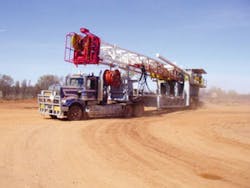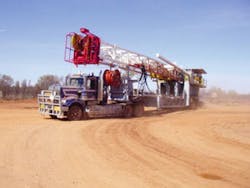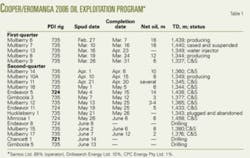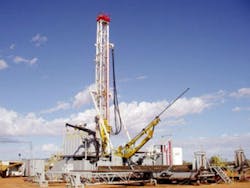Adelaide-based Santos Ltd. plans to spend $160 million (Aus.) to drill 100 wells in the Cooper and Eromanga basins in its new oil exploitation program. The initial program targets 6-7 million bbl of proven plus probable net reserves.
Contingent upon success, Santos may release another $110 million (Aus.) to drill an additional 70 wells, targeting an additional 4-5 million bbl proven plus probable reserves.
After more than 40 years since its first gas discovery in the Cooper basin, Santos announced it would spend another $900 million (net; Aus.) in a $1.3 billion program to renew its reserve base. Santos’ share of production to date is more than 100 million bbl oil, and the company estimates 700 million bbl in place in the Cooper basin.
Earlier this year, Santos managing director John Ellice-Flint said that the company could drill as many as 1,000 wells from now through 2010, targeting 75 million bbl oil (Santos’ share: 50 million bbl). He said that the key to the program is “applying technologies such as 3D seismic to better target the shallow oil reservoirs” and using three newly imported automated drilling rigs “to produce the oil at a low unit cost.”
Santos is using 3D seismic to design a pattern drilling operation and plans modular gathering facilities that will be scaleable, based on drilling results.
The company holds acreage in the Tintaburra block, encompassing several oil fields. The 51-well, eastern Tintaburra block drilling program has three phases: Mulberry area (45 delineation wells), Aros trend (3-4 near field exploration wells), and Mugginanullah (1-2 NFE wells), according to Drillsearch Energy. Participating interests in the block are Santos Ltd. 89% (operator), Drillsearch Energy Ltd. 10%, and CPC Energy Pty Ltd. 1%.
Santos was among the few oil companies worldwide to report increased reserves in 2005. Santos added 122 million boe to its proven oil and gas reserves; only 2.1 million boe came from its acquisition of Basin Oil Pty. Ltd. (OGJ, Apr. 10, 2006, p. 25)
Targets
The primary target is the Jurassic Birkhead formation, about 146-173 million years old.
According to the Australian Government’s stratigraphic units database, the Birkhead is a “westerly lateral extension of the Walloon coal measures but more sandy and less coaly in composition” and can be up to 90 m thick.1 It is conformably underlain by the Hutton sandstone and overlain by the Namur formation. Oil pay has also been found in both the Hutton and Namur sandstones. The Birkhead formation is in the Cooper, Eromanga, and Surat basins.
The Mulberry-1 well was drilled in 2004 and was producing about 600 bo/d in April. The new wells will test the Birkhead 11-77 sand, found in the Mulberry 1.
Drilling program
Santos Ltd. has brought three new rigs to central Australia from Precision Drilling International, a division of Weatherford International Ltd.: PDI 735, 724, and 721 (Fig. 1). These are fast-moving, self-elevating, fully automated, truck-mounted rigs with very small footprints. The rigs feature automated pipe-handling equipment, mechanized bulk mud-handling systems, and air-conditioned driller control cabins. (Fig. 2)
Surface casing is being set at about 240 m and 7 7/8-in. diameter hole is drilled to TD for the shallow wells. The rigs can drill to 3,000 m.
The first of the new rigs, PDI 735 (400 hp; 7,200-ft depth rating), spud the first well of the Cooper Oil Project, Mulberry 6, on Feb. 27, 2006. The well was completed Mar. 7.
Overall, the PDI 735 was used to drill four successful oil wells and one water injector in the Mulberry field, PL 39, during first-quarter 2006, all “encountering significant pay and extending the limits of the field” (Table 1). The rig went on to drill seven additional oil wells in second-quarter (through end of May). Santos reported a progressive improvement in drilling time: 6 days spud-to-spud.
First production from the new drilling program began in late March; the Mulberry 6 was online within 31 days of being spud. According to Drillsearch Energy, six wells in the Mulberry field were producing oil as of May 23: Mulberry 1, 2, 3, 5, 6, 8; while 10 others had been cased and were suspended pending completion or tie-in.
The PDI 735 was also used to drill the Gimboola-3 (PL 169) and the Huckleberry-1 (PL 39) wells.
The second new rig, PDI 724 (750 hp; 12,000-ft depth rating), was assembled in Toowoomba in February-March. It was deployed in May and has drilled two oil appraisal wells in PL 57, in the Endeavor field, PL 57, in the Eromanga basin (Table 1), 15 km north of the Mulberry field.
The third rig, PDI 721 (400 hp), was assembled in April-May and began work in early June on the Chancett 1 well.
History
Santos has been exploring in the Cooper basin in South Australia since 1954 and made its first significant gas discovery in 1963 with the Gidgealpa-2 exploration well. The company expanded into adjacent Queensland and focused primarily on Cooper and Eromanga basin development into the late 1980s before geographically diversifying.
Santos began to relinquish its Cooper basin acreage in 2000, and other oil companies have taken leases from the government and negotiated title agreements with indigenous groups. The initial Cooper Basin Access agreements were made in October 2001 between three native title claim groups, seven exploration consortiums, and the South Australian government.2
The original seven exploration consortia include Australian Crude Oil Co. Inc.; Stuart Petroleum NL; Beach Petroleum NL; Strike Oil NL and Australian Gasfields Ltd.; Liberty Petroleum Corporation; Beach Petroleum NL and Magellan Petroleum (NT) Pty. Ltd.; and Tyers Investments Pty. Ltd.
New players
Adelaide-based Beach Petroleum Ltd. was the first of the new oil explorers to begin drilling in the Cooper basin on acreage relinquished by Santos. The company drilled 12 wells between June 2002 and December 2003, all but 1 successful producers. In 2005, Beach drilled 11 wells in the Cooper basin, including 6 oil wells, 2 gas wells, and 1 future injection well.
In the first half of this year, the company is drilling three wells in the Cooper basin. In May, Beach announced a new pool oil discovery in the Poolowanna formation in the Sellicks field.3
Beach Petroleum now holds interests in nine exploration areas and four oil production joint ventures in the Cooper/Eromanga basins, as well as exploration and production interests elsewhere in Australia, New Zealand, and Papua New Guinea.
Another newcomer is Adelaide-based Stuart Petroleum Ltd., which entered the Cooper basin in March 2002 and made four discoveries beginning in April 2002. Production began in July 2002, generating cash flow that allowed the company to expand into Indonesia, Cambodia, and Tunisia.
Stuart Petroleum currently holds 5,051 sq km in several petroleum exploration license (PEL) areas in the Cooper basin: PEL90, PEL93, PEL102, and PEL113. The company spent $12 million (Aus.) to drill 17 wells in 2004-05 and produced 0.9 million bbl of oil over the same period. Stuart Petroleum has drilled 7 Cooper wells in the first 5 months of 2006.
In April, minor shareholder Australian-Canadian Oil Royalties Ltd. (ACOR) characterized the new Santos-led activity as the “largest program of continuous oil drilling ever undertaken in the southwest Queensland section of the Cooper/Eromanga Basin.” ACOR said the Tintaburra oil field may contain “84 million bbl of proved plus probable oil in place.”
Based on mapping two structural highs from a new $1.1 million (Aus.) seismic survey that ACOR ran over PEL 112, and the results of the new Santos drilling, ACOR has staked two drill sites over the C-23 and C-26 prospects.
2006 promises to be a busy year in central Australia.
References
- Geoscience Australia: Stratigraphic Units Database, www.ga.gov.au/oracle/stratnames_info.jsp
- Cooper Basin Access Agreements (October 2001), www.atns.net.au/biogs/A001306b.htm
- Beach Petroleum Ltd., “Sellicks-2: New pool oil discovery,” May 24, 2006.




